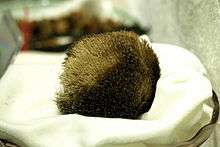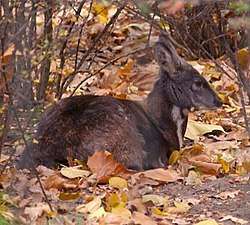Deer musk

Deer musk is a substance with a persistent odor, obtained from a gland of the male musk deer situated in its back/rectal area. The substance has been extensively used as a perfume fixative, incense material, and medicine, since ancient times. It was and still is one of the most expensive animal products in the world. The name originates from the Persian word moshk meaning "deer's navel".
Although more commonly referred to as "musk", the term itself is often used to describe a wide variety of "musky" substances from other animals such as the African civet ("civet musk") or various synthetic musks whose compound exhibits some character of deer musk.
Cultural history
The etymology of the name musk, originating from Indian Sanskrit मुस्कस् muṣká via Middle Persian مشک mušk, Late Greek μόσχος (moschos), Late Latin muscus, Middle French musc and Middle English muske,[1][2] hints at its trade route.
In Ayurveda, the ancient Indian medicinal system, musk has been used in various cardiac, mental and neurological disorders for centuries. It has also been included in various compound formulations.
Musk deer—more commonly known as Kasturi in India—of the Himalayas is one of the most endangered species in the region. Scent glands from these deer can fetch thousands of rupees and are used for manufacturing perfume and medicine.
Deer musk was unknown in the Western world in classical antiquity and reference to it does not appear until the 5th century AD when it is mentioned in the Talmud (Brachot 43.) as an animal-based fragrance. The 6th-century Greek explorer Cosmas Indicopleustes mentioned it as a product obtained from India.[3] Soon afterwards Arab and Byzantine perfume makers began to use it, and it acquired a reputation as an aphrodisiac.[3] Under the Abbasid Caliphate it was highly regarded, and the caliphs of Baghdad used it lavishly. In the early 9th century, Al-Kindi included it in a large number of his perfume recipes and it became one of the important luxury items brought by Arabian ships from the East.[3]
Deer musk has been a key constituent in many perfumes since its discovery, being held to give a perfume long-lasting power as a fixative. Despite its high price, musk tinctures were used in perfumery until 1979, when musk deer were protected as an endangered species by the Convention on the International Trade in Endangered Species of Wild Flora and Fauna (CITES). Today the trade quantity of the natural musk is controlled by CITES but illegal poaching and trading continues.[4]


Harvesting

Musk deer belong to the family Moschidae. White-bellied musk deer occurs in the Himalayas from Pakistan to China. To obtain deer musk, the deer is killed and its gland, also called "musk pod", is removed.[5]
Properties
Good deer musk is of a dark purplish color, dry, smooth and unctuous to the touch, and bitter in taste. The grain of musk will distinctly scent millions of cubic feet of air without any appreciable loss of weight, and its scent is not only more penetrating but more persistent than that of any other known substance. In addition to its odoriferous principle, it contains ammonia, cholesterol, fatty matter, a bitter resinous substance, and other animal principles.
The best quality is Tonkin musk from Vietnam, followed by Assam and Nepal musk, while Carbadine musk from Russian and Chinese Himalayan regions are considered inferior.[4]
See also
References
- ↑ "Merriam-Webster's Online Dictionary: musk". Merriam-Webster. Retrieved 2007-04-07.
- ↑ Chantraine, Pierre (1990). Dictionnaire étymologique de la langue grecque. Klincksieck. p. 715. ISBN 2-252-03277-4.
- 1 2 3 Groom, Nigel (1997). New Perfume Handbook. Springer. pp. 219–220. ISBN 0-7514-0403-9.
- 1 2 Rowe, David J. (Ed.); Philip Kraft (2004). "Chapter 7. Aroma Chemicals IV: Musks". Chemistry and Technology of Flavours and Fragrances. Blackwell. ISBN 0-8493-2372-X.
- ↑ Timmins, R. J.; Duckworth, J. W. (2015). "Moschus leucogaster". IUCN Red List of Threatened Species. Version 2018-1. International Union for Conservation of Nature. doi:10.2305/IUCN.UK.2015-2.RLTS.T13901A61977764.en